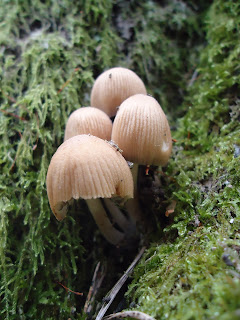Friday, 16 March 2012
Kilvey Hill
It's been very misty all week and Kilvey Hill has vanished under a dense grey shroud. I go for a foray up the hill but I don't predict to find much, if anything.
Even after five days of heavy mist the woodland floor is clearly dry. For the most part my own prediction comes true but I'm satisfied all the same when I come across two fungi fruiting in within metres of each other.
Halfway over the route I decided to take today I come across a tree covered with Coprinellus disseminatus, Fairy Inkcaps. This particular Inkcap is easy to identify because it can fruit in spectacular numbers. Coprinellus disseminatus is a fungi that creates small, fragile mushrooms, often in swarms covering dead trees and wood.
The cap is 'striate': one can see lines running from the edge towards the top of the cap. It looks oval at first then bell shaped then convex. It's worth noting that one can see ageing. Fresh mushrooms are creamy buff but they turn grey as they mature and the cap turns from bell shaped to flattening out.
The fantastic display is over quickly but it's worth seeing the mushrooms in different stages of maturity because one can see the difference and learn from that.
A few metres away was a Daedaleopsis confragosa, Blushing Bracket. This particular specimen looked rather healthy and I'm guessing that that all the fruiting bodies belong to one, singular fungi within this branch.
Below is the same fungi but it is young. I found this earlier but I'm sure it's the same thing. I've never seen this fungi at this developmental stage. If one looks at the edge one can see the maroon layers.
Bracket fungi take a long time to mature while Inkcaps take days. It's worth noticing the difference and learning from it.
Wednesday, 14 March 2012
Blushing Bracket
The Blushing Bracket, Daedaleopsis confragosa is a very common fungi that lives on dead wood. It forms a semicircular fan shape that can reach up to 20cms across and where it is attached to the wood can sometimes form a bump (umbo). Its uneven upper surface is maroon but with brown and ochre colours too, concentrically ridged.
The underside of this bracket consists of rounded and elongated pores which in the photo below is a silvery grey colour, however when handled or pressed on will turn pinkish then darker. The pore surface also darkens reddish brown with age. Sometimes found solitary or on tiers.
Scarlet Elf Cups at Clyne
Scarlet Elf Cups, Sarcoscypha austriaca are mushrooms that belong to a group commonly called 'cup fungi' due to their shape and are extremely easy to identify. The fungi fruits over winter and spring and in Clyne they were out in great numbers.
They live off dead deciduous wood that litter the wood floor and are usually attached to the substrate by a short stem as can be seen below. The inner surface is bright crimson and the outside a lighter shade which is the result of tiny hairs. They cap starts off in a typical cup shape but they can flatten out and become more tattered as they mature.
The photo below shows some tiny insects called Collembola, which feed off organic matter, including fungi.
Kilvey Hill. 26th Feb
On the way to kilvey hill, growing on a mound of wood mulch were loads of Stump Puffballs, Lycoperdon pyriforme, (above). I didn't expect to find much but there are always crusts about and other bracket fungi.
Below is Velvet shank, Flammulina velutipes.
Looking rather healthy was a lovely display of Purplepore Bracket, Trichaptum abietinum. This bracket is easy to identify due to its striking purple pore surface. This becomes more brown with age.
Friday, 9 March 2012
Flammulina velutipes/Velvet Shank
Flammulina velutipes or Velvet Shank to give it its common name is one a handful of fungi that fruit over winter and is easily identifiable.
The cap is a tan-yellow orange that's darker towards the centre. Although there are no photos here, the stalk is yellow at the apex but gets darker towards the base and is very velvety. It lives on decaying deciduous trees.
The first two photos were taken on 24th of February. the second two ten days later and one can see how the mushrooms have matured. These mushrooms are edible but rather flabby in texture and not really worth picking.
The cap is a tan-yellow orange that's darker towards the centre. Although there are no photos here, the stalk is yellow at the apex but gets darker towards the base and is very velvety. It lives on decaying deciduous trees.
The first two photos were taken on 24th of February. the second two ten days later and one can see how the mushrooms have matured. These mushrooms are edible but rather flabby in texture and not really worth picking.
February 2012
There are not many fungi to be found over winter but there are a few about. In foxhole I found a great display of Trametes versicolor/Turkeytail..
Living off dead birch wood was a large Piptoporus betulinus/Birch Polypore..
Still in the same place off Kilvey Road was Geastrum triplex/Collared earthstar. The fruit bodies of this fungi is very resilient.
Living off dead birch wood was a large Piptoporus betulinus/Birch Polypore..
Still in the same place off Kilvey Road was Geastrum triplex/Collared earthstar. The fruit bodies of this fungi is very resilient.
Subscribe to:
Comments (Atom)






































